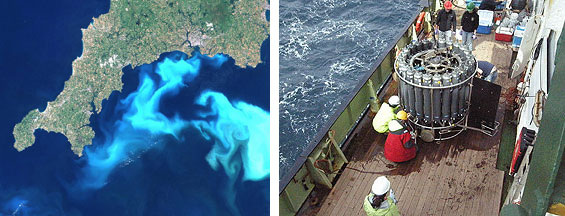Coccolithophore blooms, almost
Today’s blog entry is written by Jeremy Young, University College London, who uses both a normal light microscope and an electron microscope to work out the biodiversity of the phytoplankton at each location and through the bioassays.
In the 19th century seamen evidently did not like white water. Nowadays, however, we know that it is caused not by shoals of spectral polar bears but by coccolithophore blooms and we are rather hoping to encounter some.
... let [a mariner] be called from his hammock to view his ship sailing through a midnight sea of milky whiteness — as if from encircling headlands shoals of combed white bears were swimming round him, then he feels a silent, superstitious dread; the shrouded phantom of the whitened waters is horrible to him as a real ghost; in vain the lead assures him he is still off soundings; heart and helm they both go down; he never rests till blue water is under him again.
Indeed, we are now south west of England in an area with frequent coccolithophore blooms. These blooms occur when the conditions are just right for the growth of coccolithophores, or rather one species, Emiliania huxleyi, which then grows explosively reaching abundances of millions of cells per litre and shedding its coccoliths (calcium carbonate platelets) into the water. In extreme cases this can turn the water milky white. Satellite images show these blooms wonderfully clearly and images like the one below of a bloom off Cornwall in June 1999 have become icons of oceanography.

Yesterday we sampled waters south of Plymouth in the area of the classic 1999 bloom and satellite observations had indicated that there was probably a weak bloom in the area. The water was a bit greyer than usual, rather than eerily white, which suggested a dilute calcium carbonate soup, but to actually tell what plankton are in the water requires a bit more work. The dilute soup needs to be examined by microscopy, and the diverse plant and animal creatures identified and counted, as illustrated in the pictures.


The counts showed that we were in waters with up to one million cells of Emiliania huxleyi per litre, along with various other plant plankton. Indeed the cruise is encountering, as hoped, a wide range of oceanographic conditions around the British Isles and so highly variable phytoplankton assemblages making ideal conditions for our investigations of the interactions of phytoplankton and ocean chemistry.

